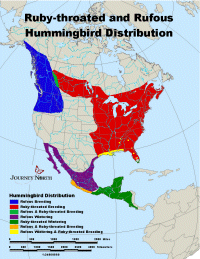Ruby-Throat and Rufous: Which is Which?
 |
 |
| Adult
Male Rufous Hummingbird
|
Adult
Male Ruby-throated Hummingbird |
Photos:
Left - Jerry Blinn, AviSys; Right - Dean Briggins, U.S. Fish and Wildlife Service |
|
With your help, Journey North is tracking both Rufous hummingbirds and Ruby-throated hummingbirds again this spring. These two species have the widest ranges of North American hummingbirds. Which are YOU watching for? Ruby-throats are generally seen in the eastern half of the continent and Rufous in the western half. But how else are they different? How big are they? What do they eat? Where are the wintering grounds, and what's the climate like there? Where are the breeding grounds? What migration routes do they travel? How far north do these two species go?
 |
| Distribution of Breeding and Wintering Rufous and Ruby-throated Hummingbirds. |
Home
on the Range
The Rufous and Ruby-throat range map can provide some of the answers.
Click the map to enlarge, and look for this information:
-
How does the latitude of each species' wintering areas compare?
-
How does the latitude of their breeding areas compare?
-
Where do the two species overlap?
Look
at the Field Marks
You
need more clues than just the range maps to identify a Rufous or
a Ruby-throat. Range maps usually only show the vast majority of
a population,
but not the handful of individual vagrants ("strays")
that some of you see and report. That complicates things, so we have
this advice: Wherever you see a hummingbird, you need to pay attention
to its field marks. Those marks tell you for sure what species the
hummer
belongs to. If
you live in the West, see Mike Patterson's tips to help you know
which hummer you're viewing:
Two
fine field guides to hummingbirds are:
• Hummingbirds of North America (Peterson
Field Guide Series) by Sheri L. Williamson, Houghton Mifflin,
2001.
• Hummingbirds of North America: The Photographic Guide by
Steve N.G. Howell, Academic Press, 2002.
Even with the best books, ornithologists can't always be certain! Hummingbirds are very tiny. Their plumage varies enough—especially for females and immatures—that some individual birds can't be identified down to species. But if you use careful judgment, look at the range maps and especially the plumage, you can usually be pretty certain which hummingbird you're seeing.
Try This! Journaling Questions
-
Create a Venn diagram to show how Rufous hummingbirds and Ruby-throats are alike and different. Besides what you learned on this page, try Journey North's search engine.
-
If different hummingbird species are so difficult for humans to tell apart, what clues do you suppose hummingbirds use to recognize one another?


